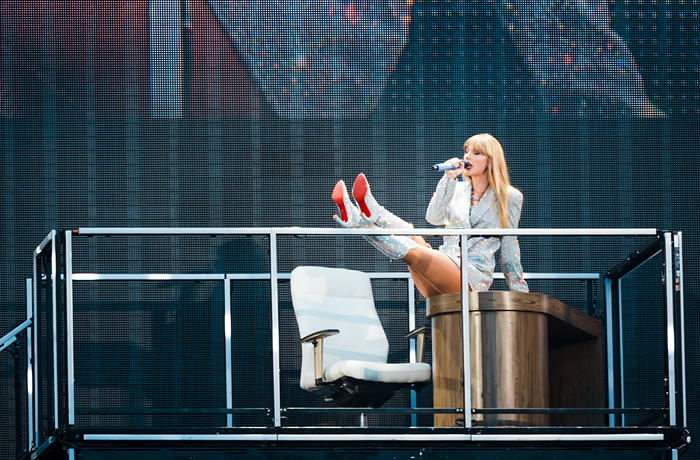The story of the French director and comedian Jacques Tati is very well-known. He was born in 1907 and died in 1982. Both of his parents were not French (one, the father, was Russian; the other, the mother, was Dutch). He began as a rugby player, was a mime for a bit, and started his film career in his early 40s. His first feature was The Big Day, and his last film was Parade, which was made for TV. Unlike Charlie Chaplin, an artist he is often compared with, Tati was not prolific. Like Chaplin, however, Tati invented a memorable character, Monsieur Hulot—black umbrella hanging from the wrist, worn hat on the head, floppy and brown overcoat over the body, funky socks exposed by high-waters, ugly but comfortable shoes, and a pipe that frequently receives a tap or two on the heels of those shoes.
We remember Tati for three films: Mon Oncle, Playtime, and Trafic. The first, and his most famous work, was made in 1958 and won him an Academy Award. The second, Playtime, which stands as his most important contribution to the art of filmmaking, was completed and released in 1967. Trafic, which is really his last film, hit the screens in 1971. Now, what connects these three great comedies? For one, the character of Monsieur Hulot—he dominates the first film, is on the periphery of the second, and is at the warm but sad heart of the third. The films are also connected by a theme: the modernization of Europeans. This social transformation, which is completed in Trafic, and accelerated in Playtime, begins in Mon Oncle.
Shot on the set of an ultramodernist home, Villa Arpel, Mon Oncle is structured by a raw dialectic between the expanding American- inspired consumerist culture and the decaying European working-class traditions and spaces. The old Europe is not obsessed with wealth, status symbols, and hygiene. All around them are dirty dogs, dust, smoke, rotting vegetables, and streets that are barely swept. This class spends its day talking and talking. Chatter is everywhere, and goes nowhere. Hulot lives in this world. His sister, Madame Arpel—a portly woman who is married to a portly Monsieur Arpel (they have a thin 9-year-old son, Gerard)—lives in what the Swiss architect Le Corbusier called "a living machine" (a strong resemblance exists between Villa Savoye and Villa Arpel). Though the house has every imaginable convenience, it's basically inhuman. The sofa, for example, is made of two beams—the larger of which barely holds the butt. The furniture is beautiful but useless, which meets the Kantian ideal but frustrates the body that desires to live as comfortably as possible.
Playtime returns to the theme of modernist architecture, but the location has moved from the suburbs to the center of the city. Shot on 70 mm, Playtime is a film with barely any plot and a lot of activity—people moving in and out of glass and steel structures. The dialectic between old world and modern world is gone, and all that remains is the domination of international architecture. People are simply thrown into this world without debate or resistance. There is no way out of it. In one scene, we see couples, friends, families, entirely from the outside of a boxy steel-and-glass apartment complex. They are in the building in the way a fish is in a fish tank. They must breathe this new air and be transformed by its severe spaces. The film is incredibly beautiful, and the old Paris, the old modernism, represented by the Eiffel Tower, is reduced to a mere reflection on a glass door.
Playtime is the social reactor out of which the new race in Trafic emerges. Tati as Hulot is a car designer—he has surrendered his simple character to the complexities of the modern world. The Parisian motor company Hulot works for is sending his experimental camping vehicle to an international automobile show in Amsterdam. The film is essentially a road movie, and the camping vehicle has absurd conveniences like an electric razor that can be pulled from the middle of the steering wheel. The most important part of the film is its end, the arrival in Amsterdam. Rain is falling on the city, which is clogged by traffic. As each car slowly passes, we see the windshield wipers behave very much like the driver. Two chatty women have fast and erratic windshield wipers. A hippie has soul-smooth windshield wipers. A poor man has a broken windshield wiper. And best of all, an old man has a windshield wiper that slowly rises and, once it has reached the apex, falls back like a dead thing. Here, we see that technology, the living machine, is no longer inhuman but now biologically attached or fused with humans.
The kind of world we are now in the process of leaving, the postmodern order of neoliberal capital and total commodification (1969 to 2009), is the world that first makes its appearance in the last of the three big Hulot movies. ![]()
Mon Oncle, Playtime, Trafic, and Monsieur Hulot's Holiday will screen at SIFF Cinema Jan 8–18 in its series "Les Affaires de Monsieur Hulot."




















